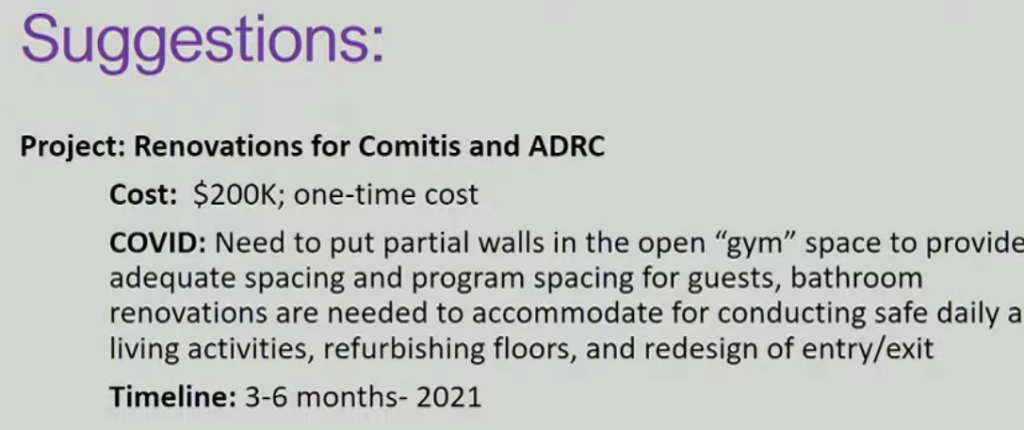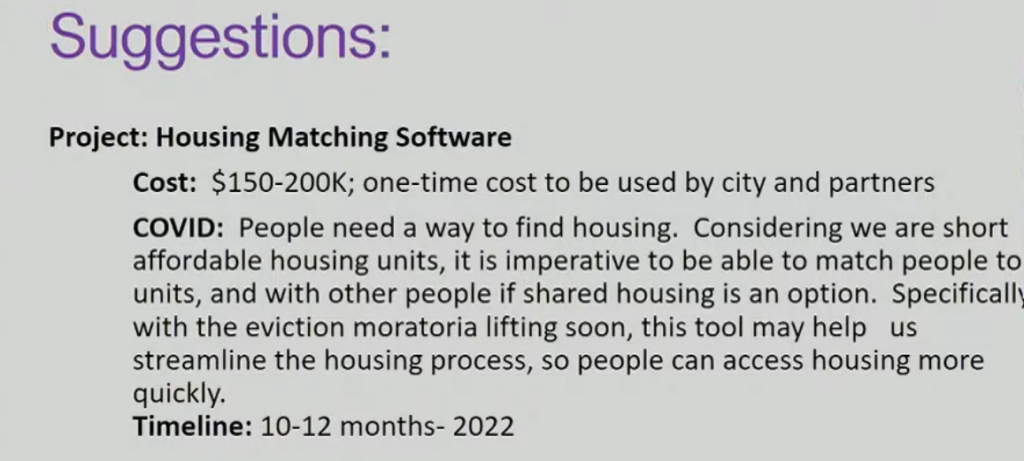
What is Affordable Housing?
4 Reasons Why Housing is Unaffordable
More Housing Resources and Referrals
Arapahoe County Department of Human Services
- Adams County Housing Authority, 303-227-2075
- Arapahoe County Housing and Community Development, 303-738-8061 – ask for Ben Nichols
- House Aurora Partnership, 303-739-7536
- Community Housing Partners, 720-251-2071
- Aurora Mental Health Center Homeless Services, 303-364-3481
- Goals Program, 303-693-1241
- Aurora Housing Authority, 720-251-2100
- Catholic Charities, 303-742-0828
- CO Coalition for the Homeless, 303-293-2217
- Colorado Foreclosure Hotline, 1-877-601-4673
- ColoradoHousingSearch.org, 1-877-428-8844
- Denver Housing Authority, 720-932-3000
- Metro West Housing Solutions, 303-987-7580
- South Metro Housing Options (Littleton), 303-794-9608
- The Crossing, 303-953-3900
- U.S. Department of Housing and Urban Development Denver Regional Office, 303-672-5258


The Graph below shows that between the year 2000 and 2016, Aurora’s eviction rate trended higher than the rest of the United States.
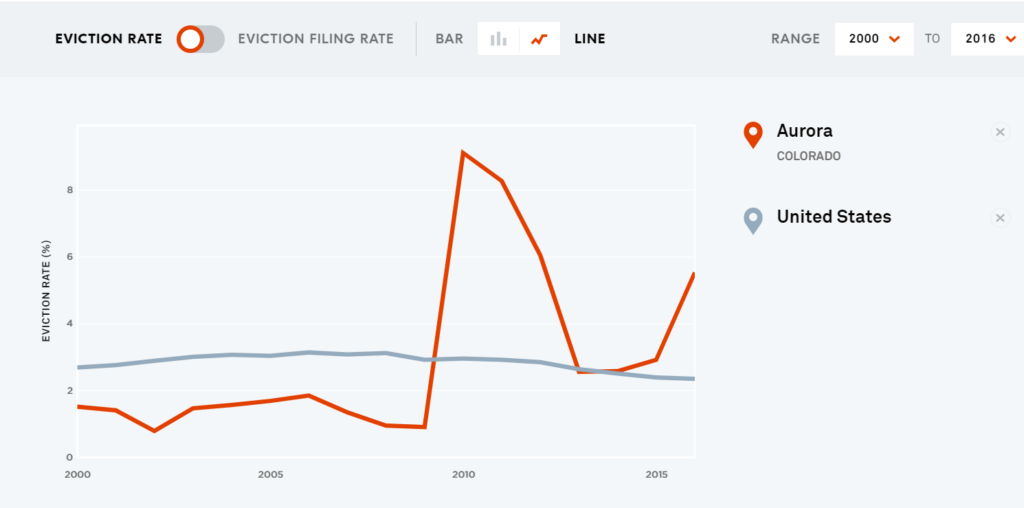
Homeless Shelters

Aurora Warms the Night Shelter Services
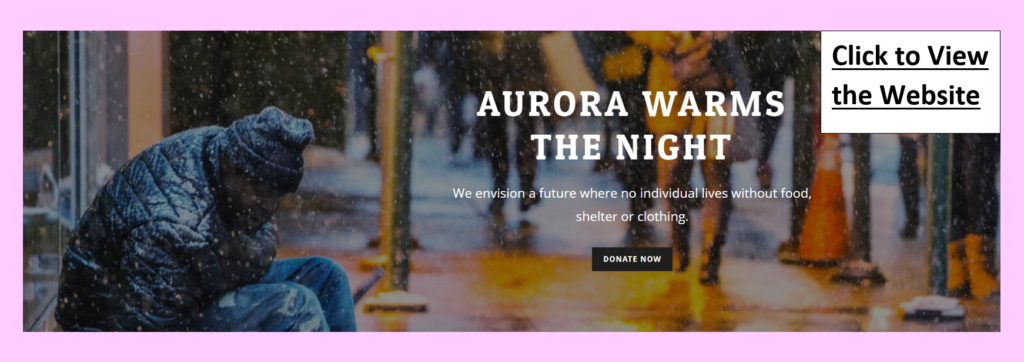
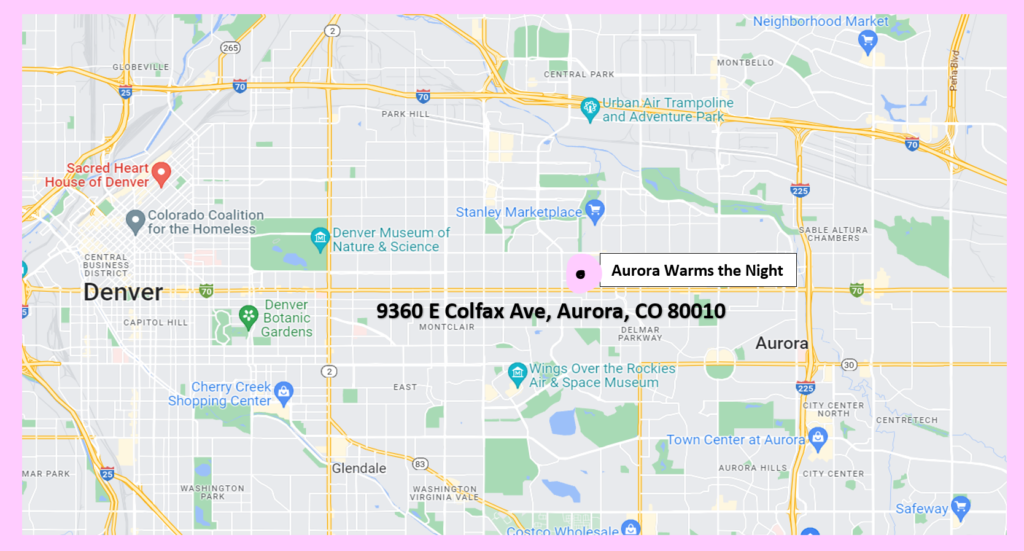
Home Tenant-Based Housing Assistance Department of Housing and Urban Development
Permanent Supportive Housing Denver Map
Permanent Supportive Housing Aurora Map
Housing Choice Voucher Program Aurora
Housing Choice Voucher Program Denver
City of Aurora Housing Data. -Auroragov.org
Chatgpt – “Give me some housing policy strategies that have been effective in creating affordable housing”
- Inclusionary Zoning: Requires developers to include a certain percentage of affordable units in new housing developments.
- Tax Incentives: Offering tax credits deductions or exemptions to encourage investment in affordable housing.
- Community Land Trusts: Nonprofit organizations that own and manage affordable housing, ensuring that the homes remain affordable for future generations.
- Rental Assistance Programs: Subsidizing the rent of low-income tenants, either through vouchers or directly to landlords.
- Public-Private Partnerships: Collaborating with private developers to create mixed-income housing developments with a portion set aside for low-income residents.
- Density Bonuses: Allowing developers to build more units in exchange for setting aside a portion for affordable housing.
- Adaptive Reuse: Converting unused or underutilized buildings, such as schools or office buildings, into affordable housing.
- Homeownership Assistance: Providing down payment assistance, low-interest loans and other support to help low-income families become homeowners.
The Low-Income Housing Tax Credit (LIHTC) Program
The Low-Income Housing Tax Credit (LIHTC) program provides a federal tax credit to investors who finance the construction or rehabilitation of affordable rental housing for low-income households. Here’s how the program works:
Allocation of Tax Credits: State housing finance agencies (HFAs) allocate the tax credits to eligible affordable housing developments based on a competitive application process. The amount of tax credit allocated is based on the eligible basis of the project, which is the total development cost minus land and certain other costs.
Sale of Tax Credits: Once the tax credits are allocated to a project, the project owner or developer can sell the tax credits to investors, usually at a discount, in exchange for equity that can be used to finance the construction or rehabilitation of the affordable housing.
Compliance Period: The LIHTC program requires that the affordable housing units remain available to low-income households for a specified period of time, typically 30 years. During this compliance period, the owner or developer of the project must ensure that the units are rented to eligible households at affordable rents.
Calculation of the Tax Credit: The amount of tax credit the investor can claim each year is based on the eligible basis of the project and the applicable tax credit rate. The tax credit rate is determined by the HFA and varies based on the type of project and the location.
Claiming the Tax Credit: The investor can claim the tax credit each year for the duration of the compliance period, as long as the project remains in compliance with the LIHTC program requirements.
HCV Homeownership
HCV homeownership refers to a homeownership program offered by the U.S. Department of Housing and Urban Development (HUD) to families that participate in the Housing Choice Voucher (HCV) program.
Under the HCV homeownership program, eligible families can use their housing vouchers towards a mortgage payment for a home they purchase. The program provides assistance to families in the form of down payment and closing cost assistance, as well as homeownership counseling and education.
The HCV homeownership program is designed to help families transition from renting to owning their own home, which can provide greater stability and financial security. The program is available to families who have been receiving HCV assistance for at least one year, have a steady income, and meet other eligibility criteria.
Here are some good resources to learn more about the Low-Income Housing Tax Credit (LIHTC):
The National Council of State Housing Agencies (NCSHA) provides an overview of the LIHTC program, including its history, how it works, and its impact. You can access their resources here: https://www.ncsha.org/what-is-lihtc/
The Internal Revenue Service (IRS) provides detailed guidance on the LIHTC program, including the rules and regulations for claiming the tax credit. You can access their resources here: https://www.irs.gov/credits-deductions/individuals/low-income-housing-tax-credit
Novogradac & Company LLP is a leading accounting and consulting firm that specializes in the affordable housing industry. They provide a wealth of information on the LIHTC program, including news and analysis, training and events, and resources for developers, investors, and state agencies. You can access their resources here: https://www.novoco.com/resource-centers/affordable-housing-resource-center
The Urban Institute is a nonpartisan think tank that conducts research on social and economic issues, including affordable housing. They have published several reports on the LIHTC program, including its effectiveness and potential improvements. You can access their resources here: https://www.urban.org/policy-centers/cross-center-initiatives/low-income-housing-tax-credit
Housing Consensus
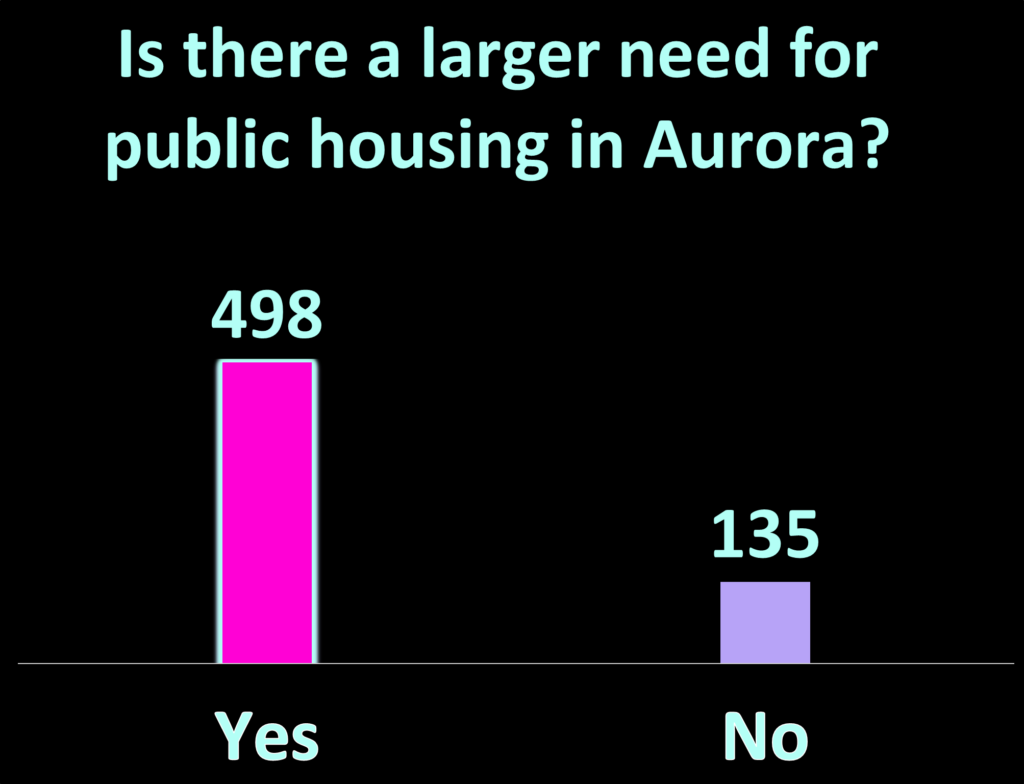
The Aurora Housing Market Study was recently passed by the Aurora City Council, but its critics say it has a small sample size of approximately 700 people out of a population of 380,000 people.
‘Councilmember Juan Marcano states that the survey showed Aurora needed to act quickly and get to work putting forward real and creative solutions to get people housed so they could fully participate in the City’s economy and enjoy the financial security that many on Council took for granted… Councilmember Curtis Gardner stated the fact remained that the City has not allowed the market to truly determine what was going to be built because of their market barriers to entry for building and regulatory costs that raised the price of the home… Councilmember Marcano felt this provided the city with an opportunity to lead by providing a roadmap for what they would like to see in Aurora based off data staff has collected… Jessica Prosser ( Director of Housing and Community Services of Aurora) confirmed there was nothing specific in terms of regulations but there were recommendations around the fee and costs with the hope to reduce some of the costs for those building affordable products.’ – City of Aurora: Minutes for Aurora City Council Regular Meeting December 11th, 2020
City of Aurora Dept. of Housing and Neighborhood Services Information
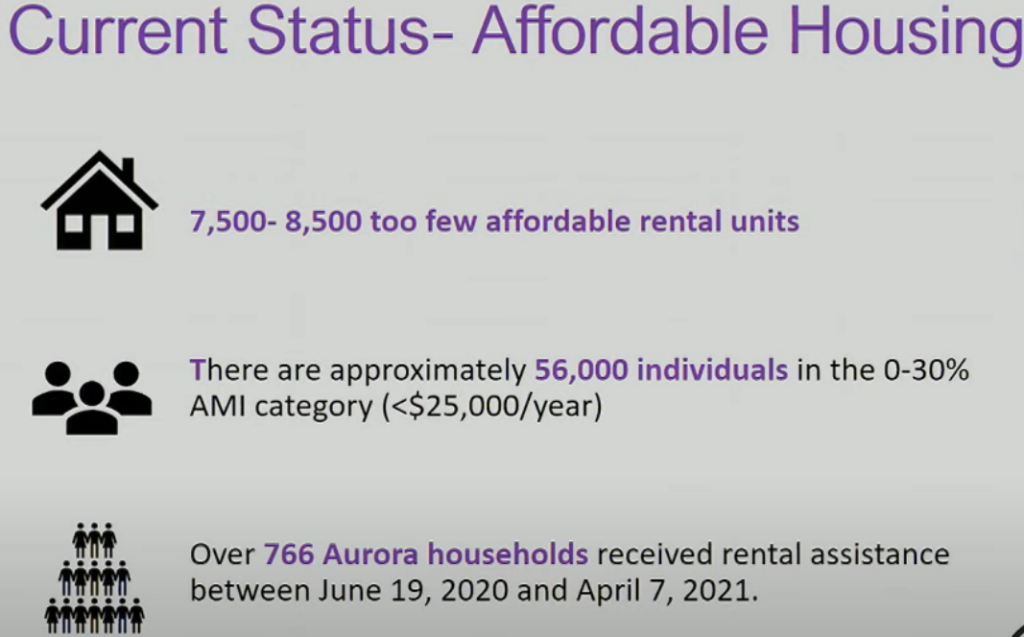

Temporary Housing and Resources
Taxpayer Housing Consensus

Houses vs. Apartments

City Councilmember Juan Marcano wants to use the Vienna Model to solve Aurora’s housing problems. He goes on to state the following at the May 3rd Aurora City Council Study Session:
“On the discussion of a shelter, just looking at the timeline in front of us, that is several years out. And tens of millions of dollars that will still preserve the status quo just with a little more space. I think that kind of harking back to the presentation that we had a little earlier this evening, we should be looking to reduce that number as opposed to continuing to let it grow and finding another place to put those folks… that shelter is too small and continuing the cycle. A shelter is not a home and there are some folks, who, for whatever reason, may be resistant to moving into a home. We all know that does happen, but there is a process and a continuum of services that get folks into a more stable form of housing. So to get to those goals my number one suggestion here is definitely to look into purchasing land. That is one of the biggest hurdles I think that we face with any of the solutions that we are talking about here. Second, and the more immediate impact, is looking at more permanent supportive housing that will address our chronically homeless community as well as helping folks who need ongoing services, get housed. Providence at the Heights is a great example of how a successful model can be, and I would like to see more of that sooner rather than later. The third issue kind of ties into affordable housing generally speaking, as that was part of the ask…and that is to find a way to leverage these one-time funds that we are getting from the federal government and other sources and put that towards something that is akin to Vienna Social Housing, which is a self-sustaining model that builds today thousands of units a year. We don’t get there overnight obviously, but we need to take some sort of long term proactive approach like that. That ties back into purchasing land and I think some of how we can start this is, in the interim, to have an immediate impact would be to focus on some of that gap financing (property loans). I know that’s something that the Aurora Housing Authority mentioned and as we just heard from staff, we have projects in the pipeline that just need a little bit to make them viable and we can get several hundred units up and coming in the immediate term. We he have this unexpected windfall…I think we need to put it towards something that is self-perpetuating and will get folks housed that we can expand over time. Make it self-replicate over time.”
Rent vs. Ownership

Based on a sample size of 419 people living in houses in Ward III, 22% rent. – Aurora Ideas data
Houses vs. Apartments


Shown above is data collected by the city of Aurora, between 2010 and 2017, median home value went up 71% but change in median renter income went up only 36%. – Aurora Housing Market Study

As shown above, only 60% of the housing units in Aurora are owned by its occupants, that’s 4% less than the nation as a whole. –Census.gov Even more strikingly, renters in Aurora are paying 20% more than the nation as a whole. Median household income in Aurora is only 3.5% higher than the nation.-Census.gov

City of Aurora, Colorado 2018 Community Survey Report of Results – Auroragov.org *Note* the # of participants in the survey was only approximately 600 people. there are more than 350,000 people living in Aurora today.
Housing is Expensive…

Aurora Housing Strategy Update January 24th, 2022
The following excerpt is taken from the Aurora City Council Study Session on January 24th, 2022. You may find the video of the Study Session at the City of Aurora’s Youtube channel under videos.
Jessica Prosser, Director of the Department of Housing and Community Services opens up her presentation by stating:
“We committed to Council that we would come back and provide some update on the different things that had happened regarding implementation of this strategy this is a brief overview of the six different priority areas and policy areas that we have been working towards. We have created some internal working groups across departments which has been very beneficial in working with developers that at looking to build affordable housing and preserve affordable housing in the city.

We have also been able to collaborate on things like rental assistance and some of our homelessness services as well as across the city. With the departments coming together, that has happened over the past year, I would say that, overall, there has been a lot of interest in affordable housing in Aurora. We have about 20 different projects in the pipeline and continue to hear from developers at our Office Development Assistance and through the Department of Housing and Community Services.
In our production and preservation area we have focused in on our community investment process. This is something we are doing twice a year. We are getting ready to release our winter round funding which I will talk about in a moment.
Over the past year we have been able to support 614 new rental units as well as 125 home ownership options. Our community investment process compiles our different federal funding sources both through HUD as well as our private activity funds to have a competitive process for developers that own affordable housing to apply. So this breaks down the different projects that we have supported. It has the areas of the city. It has the number of units associated with them and the different income levels that are supported, and again, average median income for a family of 4 is 80%, which is where the threshold is for most of our funding is about $80,000 dollars.
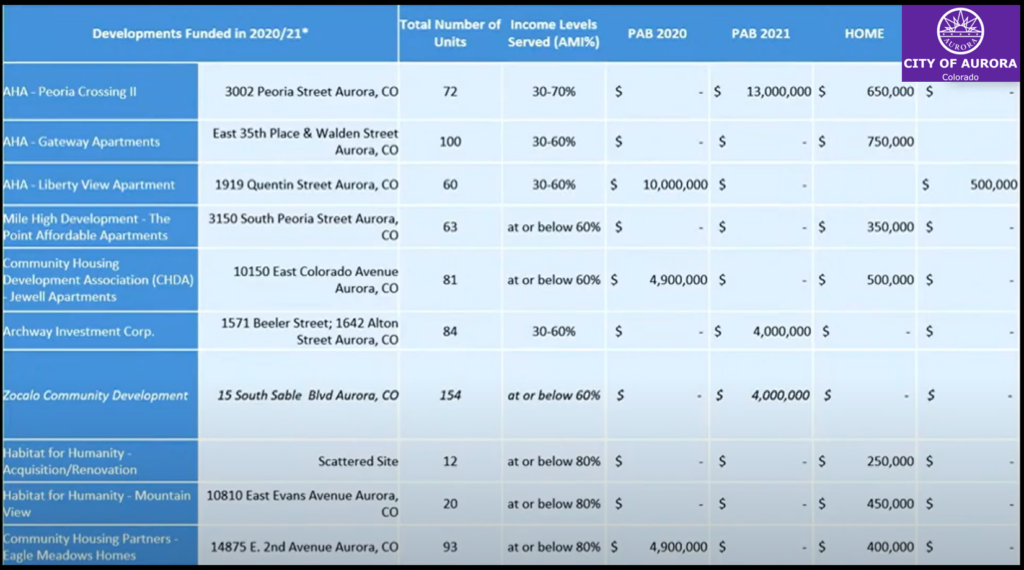
Then we have the different funding sources that were attributed to them. The private activity bonds have been very competitive over the past over the past two years with the demand for them and the way that the Colorado Housing and Finance Authority looks at this is that they are really looking for local commitment of private equity activity bonds to then match at the state level, so we have a lot of developers coming to us to then want to go to the state to leverage our local dollars…The City received a grant from the department of local affairs for $112,500 dollars to do some policy analysis around incentives for affordable housing. When we work with our Office of Development Assistance we often get asked about fee waivers. We get asked about softening some of the things om the Unified Development Ordinance. Some things we already have in there related to affordable housing…The City is not having to put any of our dollars towards doing this analysis. We did receive the grant. We are still waiting on a grant agreement from DOLA, so we have not even started yet, but this came out of House Bill 2112-71 last year.

We applied for that, and there will be more to come on that. We will kick off our round of community investment this Wednesday. We have already done an outreach to developers. They know this is coming. We have 21,000,000 dollars of private activity bonds, 3,000,000 dollars of home funds, 1,500,000 dollars of community block grant money. We will be putting 1,500,000 dollars of the 5,200,00 dollars in ARPA funds already put forth in the 2022 budget for affordable housing to try to incentivize more of those pipeline projects that are coming soon. Several have readiness and are in sort of a shovel-ready mode. Others are more in the pre-planning and feasibility studies at this point. We will be bringing all of those back through the process and into City council as we get those back. We will have them back by mid-February, and so, you would expect those agreements to be coming back sometime in March to City Council.”
January 24th, 2022 Safe Open Space Update for the Homeless
This information was takend from the City of Aurora’s January 24th, Study Session on the City’s Youtube Channel.
Lana Dalton, Homelessness Programs Manager for the City of Aurora states,
“I’m just going to give you and informational-only Safe Outdoor Spaces update from the Housing, Neighborhood Services and Redevelopment Committee (HoRNS) has decided to move this forward…We have a safe parking lot…the operator of that location is the Colorado Safe Parking Initiative. We have total number of 20 vehicles allowed, however, we have increased that to 36 to allow for individuals that have been displaced from the fires and to allow them to sleep in their vehicles at that location. The lot opened in June of 2021. So far we have had 61 vehicles who have been referred to the lot.

We do go through a very intense process to make sure that folks that have criminal histories are not mixed in with individuals that have families with children that are also living in the lot. There were some folks that were denied due to criminal history…20 households have been provided safe parking…Out of those 7 household exiting the lot, we have had a 42% success rate of obtaining permanent housing, so that is double a traditional shelter model, which is pretty impressive. Some of the requirements include, folks have to have registration and insurance, no sex offenses and no contact with police for the last 3 years. There may be some exceptions made depending upon if the review committee decides that that would be appropriate for this individual or family to be there. It operates 24 hours a day with quite hours from 10pm to 5am . They have a zero tolerance for substance use and after 3 days of no contact of you, your vehicle leaves the parking spot and they don’t return then they will give that parking spot to another family., or individual can park in that spot in the lot…
This is our pallet shelter site, so it first opened in July of 2021 with tents, but we have swapped those over to 30 pallet shelters. So far the shelters cover 109 people. The average length of stay is between 80 and 90 days. There are wrap-around services offered at this location as well. Those include case management services, housing navigation employment, behavioral health benefits, medical and basic needs.
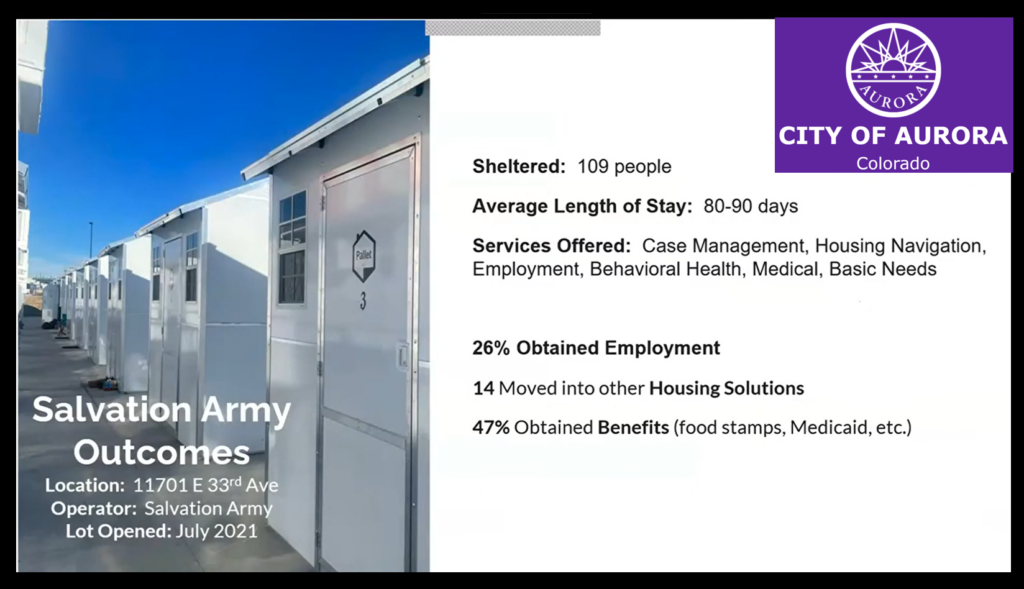
26% of the individuals have obtained employment, 14 have moved on to other housing solutions, much of that including permanent housing or reunification with family and 47% of these folks have obtained benefits that they have had in the past, so things like food stamps and Medicaid.
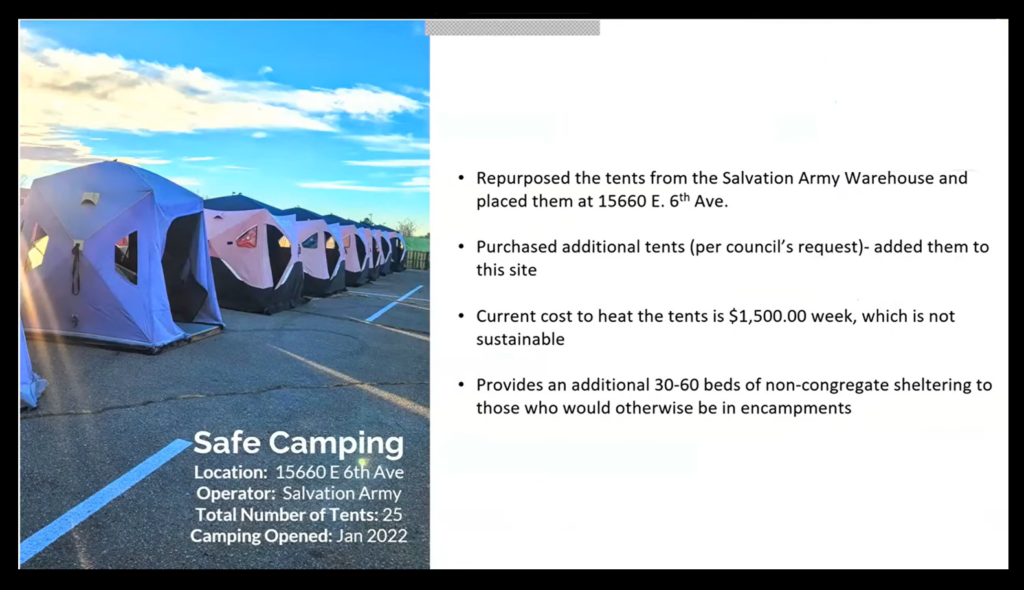
We repurposed the tents that were at the safe outdoor space at the Salvation Army and the operator there is also Salvation Army, so there is 25 tents on a lot. We purchased additional tents as well per Council’s request. They were that army tents that we replaced on this location, but the current cost to heat the tents there is about $15,000 dollars a week. They are running off a generator which is not sustainable from a cost perspective, so we are looking for other options…but this also provides an additional 30-60 beds in a non-congregate shelter for those who would otherwise be in encampments. Predominately, individuals that are experiencing unsheltered homelessness that are probably going to go to a congregate shelter option, choose these over that because this is more of a comfortable setting, or it provides them access to have their pets, or couples can stay together, whereas in a traditional shelter option that is not the case…This site opened in late December, early January of this year.
Currently, we have an emergency solutions grant Covid funding spend down that we have to adhere to to be in compliance with our HUD guidelines. We have been allocated $5.4 million dollars of ESG-CV. Our spend down is 80% by March 31st of 2022, and that’s about $4 million total. Our total spent aid is about $2.7 Million, so we have to spend about $1.33 million dollars by March 31st in order to be in accordance with our HUD guidelines.
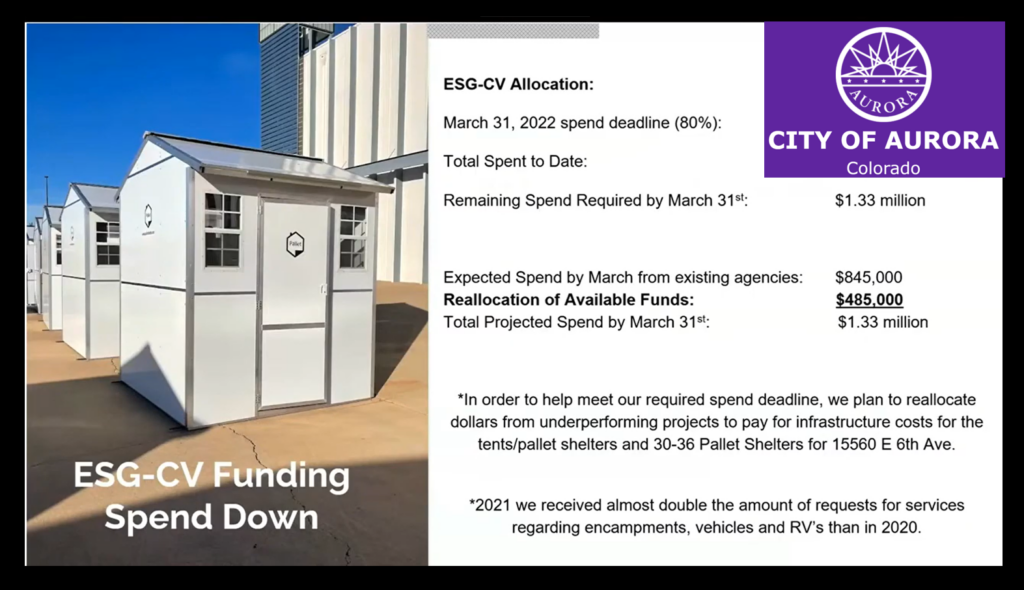
Right now we do have all of our service agreements that are going, but we do have some folks that are underperforming and so we plan to re-allocate those funds which is about $485,000 dollars to provide infrastructure costs for the tents and pallet shelters at the new location and purchase 36 new pallet shelters at that location as well. in 2021, we received almost double the amount of requests for services regarding encampments, vehicles and RVs than in 2020, and so, I would just like to put that out there as well in regards to the purchases moving forward with these safe outdoor space sites. With that, are there any questions?”
Councilmember Bergan: you said that July, 2021 the council approved the 30 pallet homes and the 30 tents and then did you?
Lana Dalton: I think that was more like October. We just had tent operations started in July.
Councilmember Bergan: I was going to say, I remember it being late October, so we did not actually use those pallets until late December, early January?
Lana Dalton: No, so we have been operating those for about since they got put up. So, I think we started in about November 1st is when they were operational and We have seen some great success with having the pallet shelters.
Councilmember Bergan: Where did the average 80 – 90 days come from? Because basically November, December, we are not done with January, so are they moving out at this point?
Lana Dalton: So that’s in totality of all of the sites. So when we are looking at safe parking, when we are looking at, when we have the tents out – the Salvation Army Location and as they transition into pallet shelters, when we take all of those things together we are seeing the average of the space.
Councilmember Bergan: ok, so that included the parking. Now when we approved the pallet homes and the tents it was for cold weather activation and so are those going to close down April 30th?
Lana Dalton: So right now, with the pallet shelters that we have at the current location on the Salvation Army Site, the plan is it’s on a temporary use permit now, so I don’t foresee those shutting down at this point in time, particularly because we have a large unsheltered population and we really have limited access to any sort of sheltering options for those folks.
Councilmember Bergan: Ok – I was under the impression that we approved them based on cold weather activation because the discussion was – how quickly can they be stored and put away, and it was kind of like, there was a discussion of not getting any pallet homes because the tents were easier to store. Now I’m hearing we aren’t going to do away with them and we are going to keep them up permanently.
I wouldn’t say permanently. I would say continuing our temporary basis. I just know that we do need access to additional sheltering options for folks. If we took away the additional shelter options that we have placed up in the city of Aurora right now, we would be left with 130 to 165 beds at any given evening and we have at least 600 people that would access shelter otherwise.
Councilmember Bergan: We don’t have 600 folks that are using.
Dalton: We don’t, but we are incrementally making strides to try to allow folks to access shelter and wrap-around services so they aren’t camping on the streets.
Councilmember Bergan: I thought the cold weather activation with all of this was because the Day Resource Center takes people during cold weather but because of covid and the spacing, they were able to take less people and I think that’s why we ended up on this other path. So I am concerned that it’s going to be a permanent situation when I thought it was going to be temporary. So the tents that you said still need heating, they only need heating when it’s cold weather.
Councilmember Bergan: You said 42 percent success of permanent housing? So how did they transition from tents and pallet homes to permanent housing? Was that through grant programs to get rental assistance or?
Dalton: Yes, so there is a variety of different ways. Part of it was employment on their own by being able to stay in pallet shelters they are able to save enough money in order to have the sustainability to be in a permanent housing solution. They worked very closely with case managers and housing navigators to get into a deeply affordable unit to meet their need based upon their income. That was another thing of navigating all of that. Some did access grants as well, so we have an emergency solutions grant that offers homelessness prevention as well as rapid re-housing dollars. So that is helpful along with our Aurora flexible housing fund to help people get up on their feet.
Councilmember Marcano: Lana, can you give us an estimate as to when some of those funds are going to be repurposed for the expansion of pallet shelters and also, could you let us know the general sentiment from both the folks we are helping and the folks who are helping us help other folks about the efficacy of tents versus pallet shelters?
Dalton: I would that the individuals that changed over from the tents to the pallet shelters – it was a really interesting dynamic because they all showed up in the morning refreshed and ready to go to access service and work with our case managers. Whereas before, the tents still can get really cold. They have a space heater. The air values are very low in the tents and so you definitely see a larger engagement with those folks that are in the pallet shelters because they can actually rest and sleep because they are not so cold that it causes people to stay up and or do other things because they just can’t get comfortable. Also, I would say the same thing, because we had a mild winter to start, we had a couple of warmer days and they are equipped with air conditioning as well.
Dalton: the purchase would have to require prior to March 1st of this year. The infrastructure for tents is something we are looking at doing anyways because of the astronomical electrical costs that are associated with it. Our hope is to have something in place within the next 2 to 3 months.
Councilmember Marcano: my recollection is that when we were discussing this originally we were treating these as short to midterm, right? Like basically as an interim solution until sticks and bricks and more permanent housing effectively can be built. Is that correct?
Dalton: Yes, that was my intention for sure just because we don’t have the ability to build out something that would be appropriate for the population that we are seeing currently.
Councilmember Sundberg: it’s good to hear and see the number of those achieving employment and then transitioning out of there to something more permanent. A question regarding the 1,500 dollars a week for heating, is that propane? Or what’s happening there with that high cost?
Dalton: So those are just fuel costs around the generator that they have rented. So yes, that’s not even the rental cost for the generator itself. It’s just fuel.
Crystal Murillo Resolution: Housing as Human Right
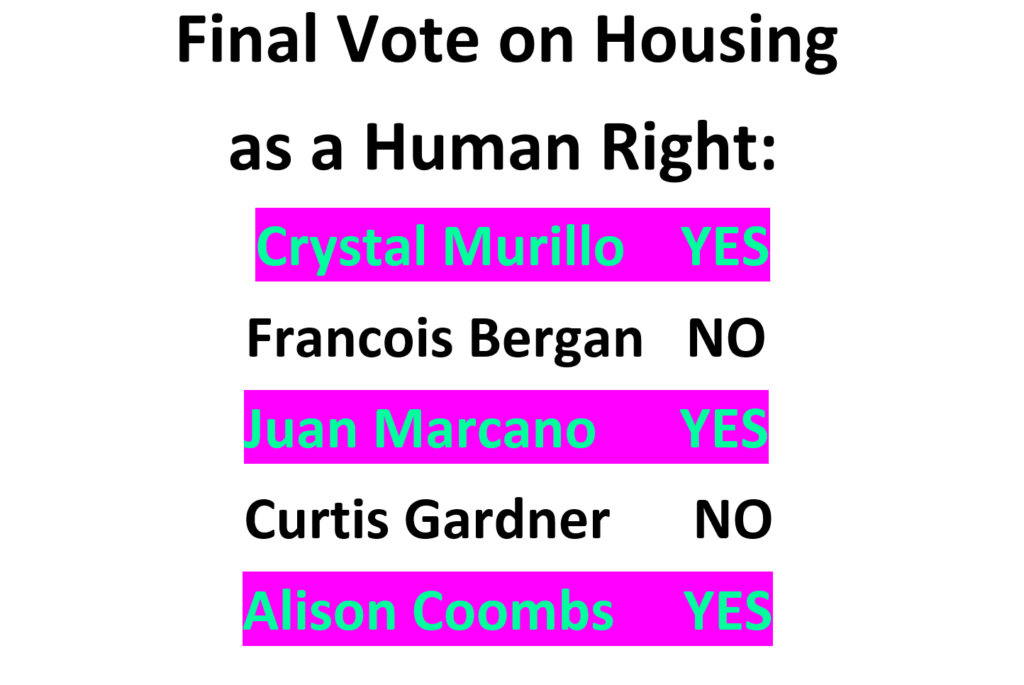
Councilmember Crystal Murillo introduced Resolution “Housing as a Human Right” in March 22, 2021 Study Session that expresses the Aurora City Council’s support that housing is a human right. Councilmember Murillo stated, “In coming up with this resolution we wanted to offer a mechanism through resolution to be able to help guide our staff to prioritize those recommendations that we believe, collectively, we should be prioritizing now. That is affordability…there are also some suggestions related to some state legislation that have been barriers for us to fulfill some of these more affordable housing recommendations as well.” Councilmember Curtis Gardner countered, ‘Wanting something to be a right doesn’t make it a right. so there are a lot of things that I would like to see in the world, but it doesn’t make them a right. Rights actually exist to limit the influence of government in our lives, so anything that’s considered a right that requires the consumption of what others produce can’t be a right, because it infringes on the freedom of others.’ Councilmember Alison Coombs responded, “If you look at the United Nations Universal Declaration of Human Rights it’s not ensuring that government doesn’t rarely interfere in people’s lives. Most human rights and most of the accepted human rights discourse is actually focused on ensuring that people have things like dignity. That people have things like food, housing and the ability to aspire to, as well as achieve certain capabilities…” Resolutions are symbolic in nature and are non-binding, meaning they are not enforceable by law. They are purely symbolic and represent the general philosophy of the council. The Resolution “Housing as a Human Right” passed on April 12th, 2021. *Note* If an ordinance or resolution is passed in the Regular Meeting then it must be voted on again, two weeks later, at the Regular Meeting for final approval.


City of Aurora Dept. of Housing and Neighborhood Services Guidance
